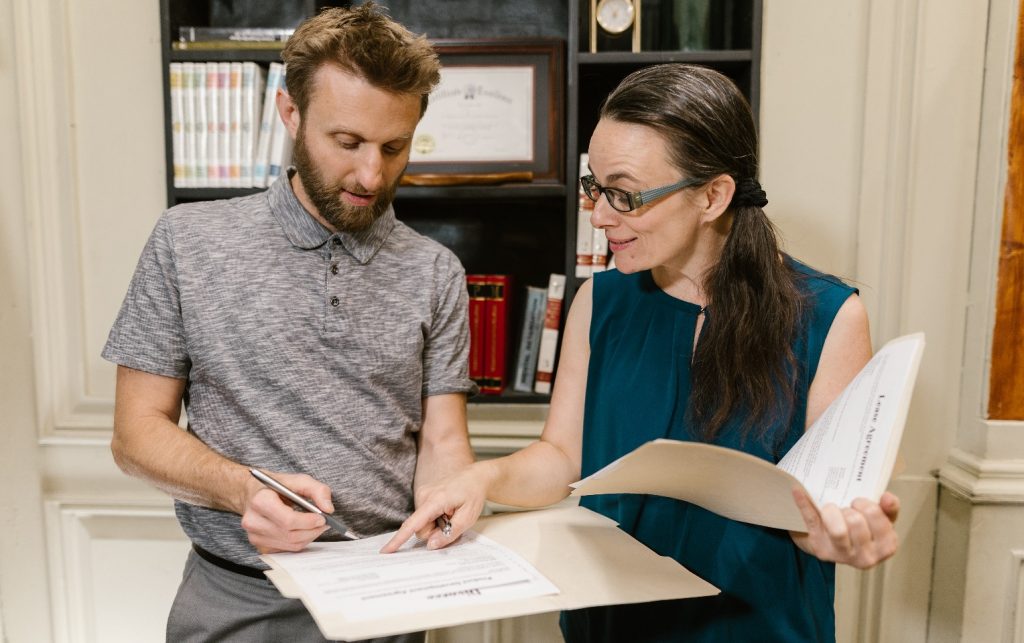Last Updated on October 23, 2024
A decision to end a marriage is never easy and presupposes lots of hard work and expenses. The complexity of the divorce process in New York depends on many factors, such as the type of marriage dissolution, the couple’s ability to get along, and so on. In general, getting a divorce in NY requires spouses to go through the following steps:
- Checking if they meet the residency requirements.
- Discussing the type of divorce to file for.
- Finding and completing the paperwork.
- Filing the forms with the court.
- Serving the spouse with the copies of forms.
- Waiting for the spouse to respond.
- Going through the waiting period.
- Exchanging financial documents.
- Attending the hearing or a trial.
- Resolving post-divorce issues.
How to Get a Divorce in New York
Applying for divorce in NYC is a relatively long process that consists of various steps, all of which should be followed precisely. There is also a specific timing for each step and rules as to who can execute some of them. Any mistakes in the process might potentially compromise it all and force you to start from scratch.
You can hire a lawyer to handle the paperwork and divorce application in NY if you don’t feel confident going through it on your own. If your spouse won’t contest, and you want to save some money on your divorce, working with an online divorce service is a preferred option. You will already have all the necessary paperwork and the instructions for each step you have to take further.
Step 1: Checking Residency Requirements

If you want to end your marriage in New York, you need to make sure that you meet the residency requirements. The court may not have jurisdiction over your case if you don’t. According to New York divorce laws, to file in the state:
- You or your spouse must have resided there for at least 2 years.
- You and your spouse should have continuously resided in NY for at least 1 year prior to filing. Moreover, you and your spouse must have gotten married in the state, resided there married, or the grounds for dissolution had to have occurred in the state.
- Both of you should have been residents of NY by the day you started the marriage dissolution, and the grounds should have occurred in the state.
Step 2: Discussing the Type of Divorce

According to New York state divorce law, a couple can get either a contested divorce if there are issues that cannot be resolved without the court’s involvement, or a no-fault uncontested divorce, which is easier and less expensive:
- Uncontested divorce in New York is an amicable kind of marriage dissolution, which is preferred by many US couples these days since it is less stressful than a contested option and does not necessarily require hiring a lawyer. If you and your spouse want to file for an uncontested divorce, you need to be in agreement on child custody and support, alimony (if needed), property division, and so on.
- New York contested divorcepresupposes that a couple cannot manage to come to an agreement on some of the divorce matters. In this case, each party has to hire an attorney to represent them and even involve witnesses and experts in some cases. Overall, a contested divorce is considered an extremely stressful, lengthy, and costly process.
A legal separation in New York is an option that couples can choose if they don’t want to initiate a divorce case. It presupposes that spouses live separately and create a Separation Agreement. This document will detail the terms of their separation, and spouses must both sign and notarize it. In a year or more, they can divorce on the basis of this document if one of them decides to do it.
A domestic partnership in New York state is a relationship that is officially recognized by the state, and it differs from marriage in some legal aspects. If you decide to end a domestic partnership, the process of termination will be different from that in a divorce, requiring fewer steps. Please, note that you have to be in a registered domestic partnership in order to end it officially through the court.
Step 3: Preparing the Paperwork

The next important step is collecting and filling out divorce paperwork in New York. First of all, you will have to prepare a Verified Complaint. This is a document where you provide the reasons for your divorce as well as the most essential details, such as names of parties, date and place of a marriage, etc. You will also need to file the Summons and check if any other paperwork is required. Some of the forms can be found on the official website of NY courts, and you have to make sure they match your divorce situation.
When filling out the forms, you need to read each question carefully to provide a full answer without adding details that might be asked of you in other sections. Make sure you have not written anything in the fields that must be left blank, and do not forget to proofread for mistakes. Also, please note that some forms, such as Verified Complaint, must be signed in front of a notary.
Those divorcing amicably can take advantage of online divorce in New York, getting help from a reliable online divorce provider like ours. For a flat fee of $159, you will receive a full packet of court-approved forms, already filled out for your case, as well as a detailed step-by-step guide on filing for divorce in New York.
Step 4: Filing for Divorce

As soon as you complete, print, and sign all the necessary New York state divorce papers, you should file them with the court clerk’s office. You will also have to pay a filing fee, which is approximately $210. There may be other fees, for example, for the copies of documents, which you may inquire about in court.
The couples are also allowed to file for divorce online in New York. They may do it through the New York State Courts Electronic Filing system if it is available in their county. However, please note that this option is only available for those spouses who don’t have contested issues.
Step 5: Serving the Divorce Papers

After you have filed the documents, you need to inform your spouse about doing so by serving them copies of the documents. Serving divorce papers in New York can be done within 120 days after filing.
In NY, you can serve the papers on your own if your spouse will not turn your divorce case into a contested one. Alternatively, you can hire any third party over 18 years to do it. Such a person will have to fill out and file an affidavit confirming they served your spouse.
Step 6: Filing the Response
After the service is completed, your spouse has to officially answer to it. The served party must sign the Affidavit of Defendant within 20 days if they are a resident of the state or 30 days if they are in another state and send it to you so that you can file it with the court.
The defendant may also disagree with the terms stated in the papers and file their own Answer with the court, making a divorce contested. When the defendant provides no answer at all, after a period of 40 days passes, the petitioner may proceed with further steps without the defendant’s involvement.
Step 7: Waiting Through the Settlement Period

In many US states, there is a so-called “cooling off period” during which the couple may reconcile and choose not to proceed with the divorce. There is no divorce waiting period in the NY state, but you will have to wait for the necessary number of days to pass if your spouse delays the response or decides not to provide it.
Step 8: Presenting Financial Disclosures

The disclosure process requires spouses to exchange their financial information with each other and file it with the court. This would be information on credit cards, tax statements and returns, debts, assets, bonuses, deductions, etc. Such exchange allows spouses to get a better understanding of what each of them can request in the asset division process, who will pay child support and how much, and what the alimony might be. It also helps the court make a fair decision on such matters.
Step 9: Final Judgment

In NY, generally, divorce is finalized only after the hearings, no matter what type of case you file for. In uncontested marriage dissolutions, the hearing may be required by the judge if you have children, request alimony, or need to divide the property. The judge may review your papers and ask you some questions, and if everything is in order, they will issue a Judgment of Divorce.
For a contested case, there might be hearings and a trial that should be attended by all parties involved. After listening to both parties’ attorneys’ statements, as well as witnesses and experts during the whole process, the judge will make final decisions. A contested case may take different turns, and a lot will depend on the ability of spouses to agree on certain matters, the performance of the lawyers, and the requests the parties make with the court.
Step 10: Resolving the Post-Divorce Issues

When your divorce is finalized, unfortunately, some issues may still arise. The most frequent cases when spouses need to resolve post-divorce issues occur when they have children. For example, one of the parties may avoid paying child support or refuse to let the second parent meet the kids. In all of these cases, the affected party needs to get back to the court and request for the orders to be enforced.
There can also be circumstances when one of the parties may request to modify the court order due to a change of circumstances, like losing a source of income, moving out of state, or having health issues. The court may make a new order or modify the existing one depending on the situation.


